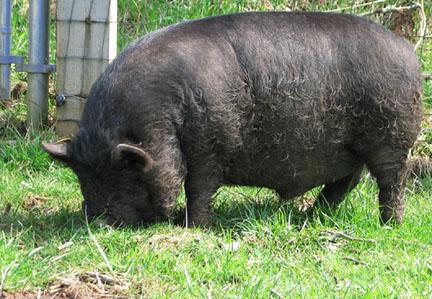








We were told that they needed a fair amount of protein in order to put on muscle and not fat.
















Irene Kightley wrote:Have you done a design for the house and land yet ? If not, an easy way to do that is take a screen shot from Google earth and mark in by hand or use a programme like Paint to mark out how the land is protected, where the winds come from, neighbours roads, types of soil/rock, where there are fences and so on.
Then do your zoning plan - you know, the house and things that you want near it in zone one... etc.































































marina phillips wrote:
Hey Paul, over at richsoil.com you have a photo of some pigs beginning to turn a huge compost pile. Said you'd update it spring of 2002 with the results. What happened?








 1
1




New Heritage Farms, SW Washington
Heritage Breed Tamworth Pigs ~ The Irish Grazer
PiGturesque Pasture Pigs ~ Pasture Perfect Pork




 ) really sweet !
) really sweet !



Irene Kightley wrote:
Lovely healthy looking pigs Vickie and those piglets are (I hate to say this.) really sweet !
New Heritage Farms, SW Washington
Heritage Breed Tamworth Pigs ~ The Irish Grazer
PiGturesque Pasture Pigs ~ Pasture Perfect Pork




marina phillips wrote:
A single mature female can have thirty piglets a year.
New Heritage Farms, SW Washington
Heritage Breed Tamworth Pigs ~ The Irish Grazer
PiGturesque Pasture Pigs ~ Pasture Perfect Pork








Alison Freeth-Thomas "heninfrance" wrote:
Vicki, those piglets are indeed just gorgeous lil silkies.
New Heritage Farms, SW Washington
Heritage Breed Tamworth Pigs ~ The Irish Grazer
PiGturesque Pasture Pigs ~ Pasture Perfect Pork




Alison Freeth-Thomas "heninfrance" wrote:
Is that for year round living? If so, how cold/windy does it get there?
New Heritage Farms, SW Washington
Heritage Breed Tamworth Pigs ~ The Irish Grazer
PiGturesque Pasture Pigs ~ Pasture Perfect Pork




Alison Freeth-Thomas "heninfrance" wrote:
And piglets - woah, I'm hoping that my sow doesn't have 30 piglets in a year. I only want her to have one litter per annum really. I guess that means that I'll have to house the boar elsewhere? With a little friend? Would two uncastrated males get on OK together?
New Heritage Farms, SW Washington
Heritage Breed Tamworth Pigs ~ The Irish Grazer
PiGturesque Pasture Pigs ~ Pasture Perfect Pork




Alison Freeth-Thomas "heninfrance" wrote:
Would two uncastrated males get on OK together?
New Heritage Farms, SW Washington
Heritage Breed Tamworth Pigs ~ The Irish Grazer
PiGturesque Pasture Pigs ~ Pasture Perfect Pork








Alison Freeth-Thomas "heninfrance" wrote:
Ahhh they're SO gorgeous. Is that a lil Jersey?
But how sad about the other lil pig. Was it because of the travel?
New Heritage Farms, SW Washington
Heritage Breed Tamworth Pigs ~ The Irish Grazer
PiGturesque Pasture Pigs ~ Pasture Perfect Pork




Alison Freeth-Thomas "heninfrance" wrote:I just wondered if there was a more 'free-range' way of keeping pigs - like does this 'enclosure' thing equate to chickens being kept in a run?
Alison Freeth-Thomas "heninfrance" wrote:And ideally what should pigs get in their diet? Should soya feature? We were told that they needed a fair amount of protein in order to put on muscle and not fat (guess that's similar to humans).
CorneliusCauna wrote:For food we have a VERY good system. We worked out a deal with a local school and a local Elder home to take there food scraps that would normally go into the trash.




pubwvj wrote:
Do not use post-consumer wastes because not only can it transmit disease back and forth between humans and pigs but it is illegal almost everywhere. Stick with the pre-consumer wastes. Give the food scraps to the chickens or compost them. Don't feed it to the pigs. They whey is great. Stick with that.
New Heritage Farms, SW Washington
Heritage Breed Tamworth Pigs ~ The Irish Grazer
PiGturesque Pasture Pigs ~ Pasture Perfect Pork








 1
1









|
The first person to drink cow's milk. That started off as a dare from this tiny ad:
The new permaculture playing cards kickstarter is now live!
https://www.kickstarter.com/projects/paulwheaton/garden-cards
|







